Some years ago, I was driving along the main route to our home in rural upstate New York when I spied a small dark terrier, scurrying along the roadside. While I was overdue at home for some family get-together, I could not leave that little lost-looking guy behind. After quite a bit of effort and the emergency enlistment of my husband and his brother, we managed to use a blanket to scoop up the little dog and get him in my car.
Once we got home and he was safely indoors, the terrier was more relaxed and allowed me to pet him and give him a look. He had a collar and a rabies tag, but no other identification. The rabies tags in our state provide the vaccinating veterinarian’s information, but the clinic was closed for the weekend. So we hosted the little stranger for the weekend.
On Monday, I called the vet’s office. To protect the owner, they would not provide me with any information but promised to try to reach the owner of the dog. It took a couple days, but finally we got a call from the owners; they were in Florida and the dog had been in the care of another family. He had traveled – either on his own paw power or with the assistance of someone who snagged him and let him go – many, many miles!
The point of this anecdote is to remind you, as I do my dog-training clients, that it is wise to make sure your dog is always wearing identification, with up-to-date contact information! Ideally, your dog’s tags have enough information that anyone who might find your dog could contact you directly, 24/7, in the event that she darts out, gets lost on a hike, etc. There are many options for you to employ!
We use multiple forms of identification on our dogs. It’s our nature to have backup systems in our home; we have a double-door system for our front door, which also is posted with a warning not to let our deaf dog out. Our dogs’ collars carry the tags, and when we walk, we attach our dog-walking harness to the collar with a carabiner.
Our tags include the required New York state license (which provides only a registration number and the name of our town, but this could be a start for someone); a rabies vaccination tag (that vaccination is required in every state in the United States – we want people to know that our dog is not a health threat); and a standard identification tag with our contact information on it. I add another tag if I ever leave my dogs in the care of a pet sitter; the pet sitter’s number is on that last tag to streamline recovery should my pups get separated from their caretakers.
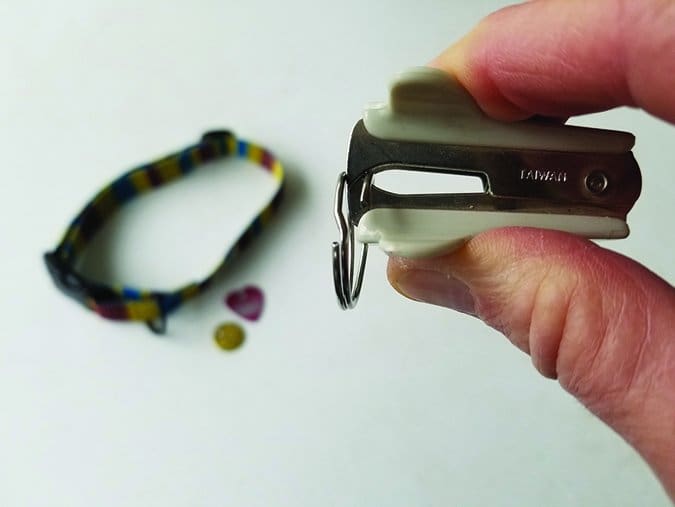
Types of Dog Tags
The tag that has my contact information on it is a metal tag that I got at PetSmart. It’s inexpensive and quick. You may want to get a fancy artisan tag if you get a new dog, but in the meantime, go to a pet supply store that has a tag-engraving machine. It’s super quick and fun! The tags are thin metal, and don’t appear to be that durable, but I’ve found them to last a few years. This type of tag is handy to get when your dog will be staying somewhere away from home and you want the sitter’s contact info on your dog.
Many pet supply stores sell custom designs, or you can go on Etsy.com and see the many well-crafted designs out there. Some of these are made out of fancier metals like brass or hard plastic. Custom-designed tags cost a bit more and may take a couple of weeks to receive. There are also a multitude of Internet name-tag companies and they often offer deals on repeat or multiple orders. I opted to add a fancy little brass tag to our little dog’s “charm bracelet.” The brass tag lets people know that our dog Helen of Troy is deaf.
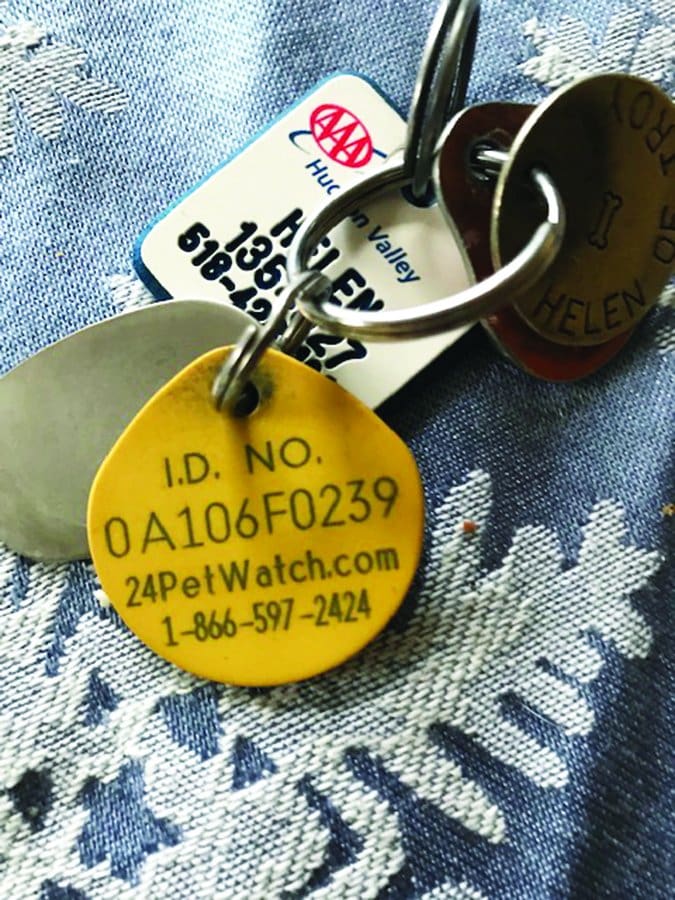
Silidog sells silicone dog tags – soft, durable, non-fading tags that are engraved on both sides with your information and shipped to you for $20 each.
Some local chapters of AAA offer free dog tags and registration for your dogs. These plastic tags sport the AAA logo, color scheme, and toll-free number. If someone finds your dog and calls the number on the tag, AAA will contact you and tell you how to reach the person with your dog. A benefit of this feature is that the tag does not display any of your personal information. Ask your local AAA representative if this benefit is available in your area.
I just received a similar service through Embark, one of the DNA-testing companies. We bought the DNA kit to test our new dog, Petey. In the box was a very nice tag with his Embark registration number and a phone number. The registration number was affixed to the tag and does not appear integral to its structure so I’m not sure how long that will last – but it’s a nice perk.
Jingle Hell?
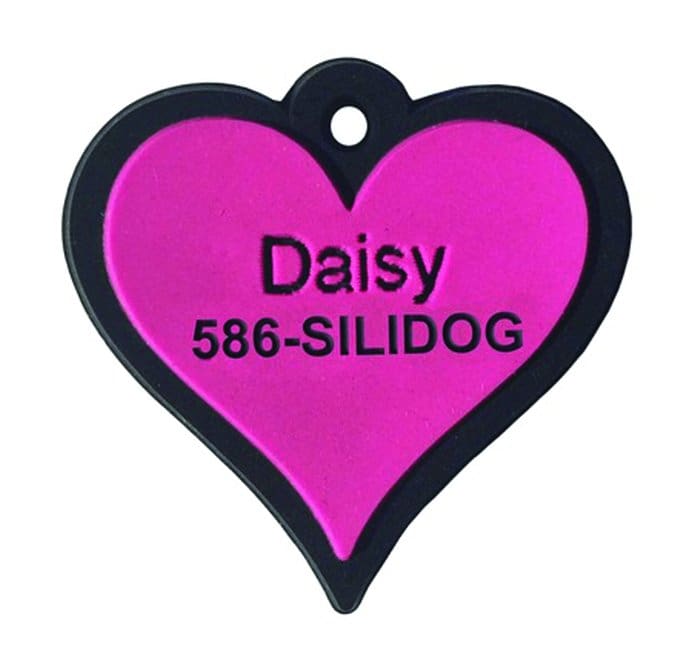
Personally, I like the jingling noise that all my dogs’ tags make as the dogs walk around my house; it helps me know where they are! But some people find the sound of dog tags very aversive. No problem! There are any number of little pouches that can contain and mute your dog’s tags.
I found a stylish leather wrap-around “tag bag” that fastens to a dog’s collar with both a little clip and hook-and-loop fabric. They are made and sold by LongDogLeather on Etsy.com, $11.
ThunderCover is a translucent silicone pouch that contains the tags. Made by ThunderWorks, the same company that makes the ThunderShirt, the pouches are available widely in stores and online. Chewy.com offers them for $8.
Tag Switching
For those of you, like me, who like to change your dog’s collar frequently, there are companies that have designed clips that can host the tags and are easily removed to place them on different collars, such as the Rubit Dog Tag Clip from Rubitclip.com ($8).
Personally, I use a key ring for attaching ID tags to my dogs’ collars; they are much stronger than the little rings that often come with rabies or license tags and are easily found in any hardware store. Remember: Never attach your leash to the flimsy rings that come with tags – they are not strong enough and you could lose both your dog and your tags!
Identification Collars
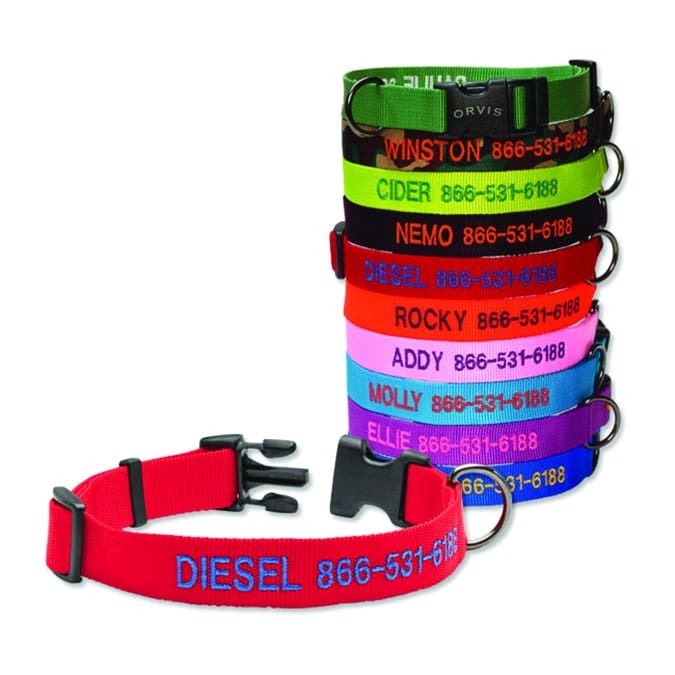
Another means of identification for those who are tag-phobic is to get a collar that has your pet’s name and your phone number sewn into or printed on the collar. This eliminates the jangling tags (though I appreciate hearing that sound so I know where my dogs are in the house).
There are a number of companies that make these collars. Orvis sells eight different models, including collars with reflective stripes and martingale collars. The most basic is the Personalized Adjustable Dog Collar, $21.
DogIDS.com offers a dozen or so more personalized options. I like their Waterproof Soft Grip ScruffTag Personalized Collar. It’s made out of a very strong waterproof material (poly-coated nylon webbing) with a built-in stainless steel plate that is engraved with your dog’s information for $34. These collars are made to a specific length based on your dog’s measurements. Note that they are made with a traditional stainless steel tang buckle; for an option with a plastic side-release buckle (which offers a quick release in an emergency), get their Nylon ScruffTag Personalized Collar ($29).
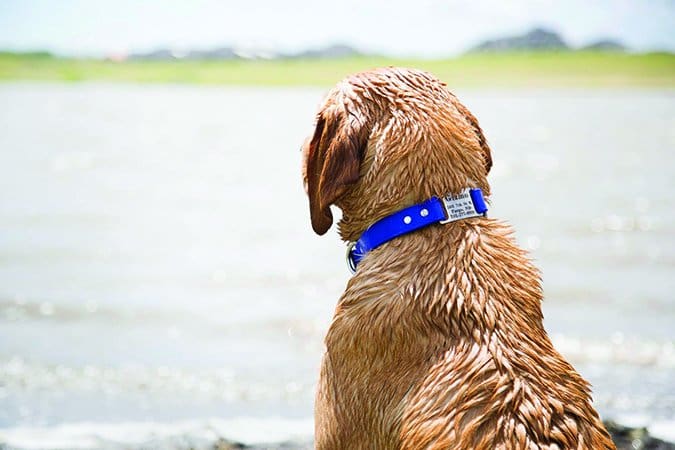
Microchipping
In addition to their tags, my dogs are also microchipped. A microchip is implanted under the dog’s skin with a needle, usually above the shoulder blades. Most veterinarians, shelters, and rescues microchip dogs routinely.
A microchip not only identifies your dog even if he loses his collar, it can confirm his identity and your ownership if he’s ever stolen.
There are a number of microchip registration companies to choose from, including Home Again, AKC Reunite, Petkey, and 24 PetWatch. Before the microchip was inserted in Petey, my veterinarian scanned the chip to make sure it was active. She said that it was rare but on occasion the chip may be a “dud.” After the chip is implanted, the technician usually scans it again, to make sure it’s still readable.
After the microchip is inserted, make sure that either the veterinarian, shelter, or you has registered the required information with the microchip company – then, it’s up to you to keep the contact information on file with the microchip company up-to-date! There is nothing a shelter or rescue worker hates more than finding a dog with a microchip, but being unable to reach the registered owner due to out-of-date contact information.
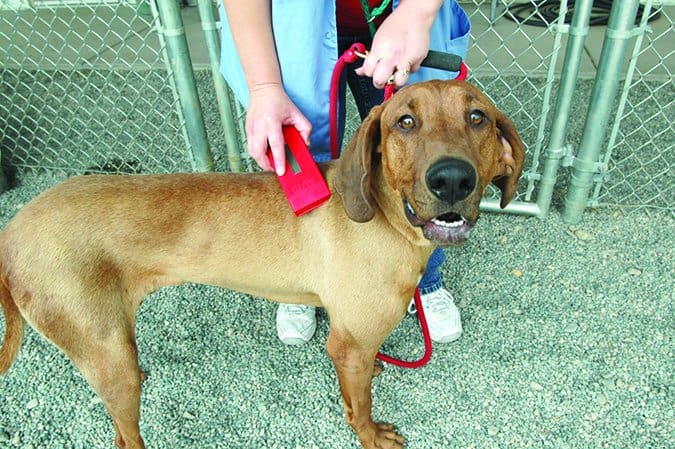
Most of the microchip companies offer a plastic tag to go on your dog’s collar that has the company’s toll-free number on it. Some of the companies, including 24PetWatch, also print a unique ID number on the tag, so even if the person who finds your dog doesn’t have access to a microchip scanner, they can still call the company and a representative will help connect them to the dog’s owner.
Tags from some of the other companies have no unique ID number on them; instead, the tags simply indicate that the wearer is microchipped. The dog still needs to be scanned so the microchip number can be reported to the chip company.
Since the inception of the microchip, there have been many rumors that they can cause diseases like cancer. While the rice-sized chip can occasionally migrate, ending up somewhere down the dog’s shoulder or leg, there is no scientific evidence to support significant harm. Depending on where you have your dog chipped, the fee for insertion and chip registration can range from $20 to $50. Some companies offer some additional services if you pay an annual fee.
Use Anything! But Use Something!
The collar and tag identification options are vast, so no excuses! Pick an option that suits you and your canine and will result in a speedy reunion lest you are inadvertently separated.






